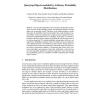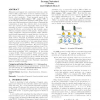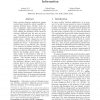37 search results - page 4 / 8 » Surrogate Ranking for Very Expensive Similarity Queries |
SSD
2007
Springer
14 years 1 months ago
2007
Springer
In many modern applications such as biometric identification systems, sensor networks, medical imaging, geology, and multimedia databases, the data objects are not described exact...
WWW
2007
ACM
14 years 8 months ago
2007
ACM
Extractors and taggers turn unstructured text into entityrelation (ER) graphs where nodes are entities (email, paper, person, conference, company) and edges are relations (wrote, ...
ICDE
2009
IEEE
14 years 9 months ago
2009
IEEE
Due to the structural heterogeneity of XML, queries are often interpreted approximately. This is achieved by relaxing the query and ranking the results based on their relevance to ...
VLDB
2002
ACM
13 years 7 months ago
2002
ACM
Many modern database applications require content-based similarity search capability in numeric attribute space. Further, users' notion of similarity varies between search se...
WWW
2008
ACM
14 years 8 months ago
2008
ACM
Learning to rank is a new statistical learning technology on creating a ranking model for sorting objects. The technology has been successfully applied to web search, and is becom...



